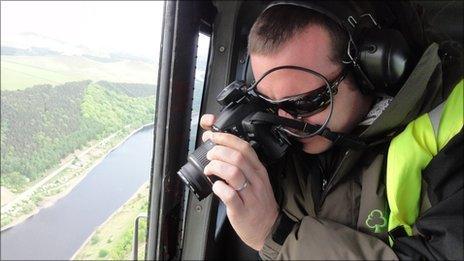Tree disease phytophthora ramorum spotted by helicopter
- Published

Photographs from the aerial survey will be matched with information on the ground before felling takes place
Ben Jones is about to take off on a six-hour helicopter trip to survey the front line in the battle against phytophthora ramorum.
His fungus quarry was first found in in the UK in 2002 in bushes like rhododendrons.
In 2009 it spread to larch and it is known to affect 130 other species of trees and bushes.
More than two million trees have been felled around the UK as the Forestry Commission tries to stop the spread of the killer disease.
The Food and Environmental Research Agency .
Aerial surveys made by the Forestry Commission so far in 2011
But with spring bringing new growth to trees, the Forestry Commission is hoping to get a true picture of the latest situation.
Larch trees shed their needles in the winter making the disease hard to spot.
The aim is to get to the disease as quickly as possible and prevent it spreading when the trees give off spores in the autumn.
The tools of Mr Jones and his team of two are a hired helicopter from Liskeard in Cornwall and a digital SLR camera.
They have already taken pictures of larch plantations mainly in the South West and along the west coast.
He said the disease prospered there because of the prevalent moist conditions.
Mr Jones said: "The variability of the weather is playing in our favour at the moment.
"Last winter was bad for disease because it was cold and this spring has not been good because it has been dry."
Their work will continue until October, taking in Scotland and Northern Ireland.
On a six-hour trip they can cover a territory up to 800 miles long and three miles wide.
On their last mission they took about 600 pictures in the Peak District.
The camera is linked to a GPS tagging machine so analysts on the ground can pinpoint exactly which areas are affected.
On each trip they are looking for signs of deterioration of the crown of larch trees which cannot be seen so easily from the ground.
Polarised sunglasses emphasise colour contrasts and the brown crowns of infected trees.
"We can cover large areas of ground relatively quickly and identify sites for teams on the ground," said Mr Jones.
"Early detection is a way of managing the situation because the more spores there are the more likely it is to spread to other species."
Landowners with infected trees get a compulsory felling notice.
is affected by the disease but landowners get .
Landowners get compensation for restocking trees
Larch is used extensively for garden furniture, fencing and pallets and is worth millions to the South West's economy.
In Devon and Cornwall, some of the worst-affected counties, 100 hectares of infected trees in the Glynn Valley have been felled.
Nearly 20 hectares are being flattened in the Herodsfoot area and work starts on Monday to remove almost 30 hectares of Japanese larch from Idless Woods near Truro.
As Mr Jones prepares to fly on another aerial survey he is optimistic the disease can be brought under control, but not eradicated.
"Eradication may be possible on individual sites but as a whole eradication is unlikely," he said.
"Like potato blight, which is from the same family, it's very difficult to control but we can manage it."
- Published7 January 2011
- Published17 August 2010
- Published15 July 2010
- Published11 June 2010